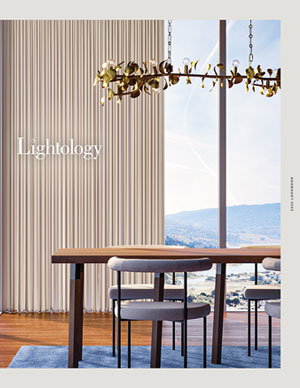Dynamic and circadian lighting is about synchronizing your indoor lights with changing daylight and personal routines. By adapting lighting to different times of day and seasonal changes, you can create a space that feels naturally comfortable, inviting, and in tune with your well-being. This approach ensures variable illumination when you need it—whether you’re waking up to early morning sun or winding down on a dark winter afternoon. Below, discover practical ways to handle home adjustments, rely on local meteorological departmentsfor guidance, and even consult seasonal décor experts to make the most of your lighting setup all year long.
What is Circadian Lighting?
Circadian lighting refers to an approach to indoor illumination that aligns with our body’s natural 24-hour cycle (the circadian rhythm). Rather than providing a static brightness and color temperature all day long, circadian lighting mimics the changing qualities of daylight—brighter and cooler (more blue-toned) in the morning/early afternoon, then warmer and dimmer toward evening. This shift in light intensity and color temperature helps:
- Support healthy sleep-wake patterns: Brighter, cooler light cues your body to be alert, while softer, warmer light signals wind-down time.
- Enhance mood and productivity: Properly timed lighting can improve focus during the day and relaxation at night.
- Complement seasonal variations: Whether it’s a short, gloomy winter day or a long, bright summer afternoon, circadian lighting can adjust to provide a more natural flow of illumination indoors.
In essence, circadian lighting works in harmony with your internal clock, ensuring your indoor environment reflects the daytime or evening ambiance your body expects.
Why Adapt Lighting to Daily and Seasonal Cycles
- Our bodies respond to natural daylight changes. When it’s bright and cool in the morning, we feel more alert. As evening approaches, warmer, dimmer light signals relaxation.
- Short winter days can cause insufficient indoor light, affecting our energy and mood. Conversely, long summer days might lead to overly bright evening interiors.
- By adjusting bulb color temperature, brightness, or even fixture placement, you maintain a pleasant environment that aligns with climate-based building guides and personal comfort.
How to Adjust Lighting According to Seasonal Daylight Variations
- Keep track of sunrise and sunset.
- Update your lighting schedule or manually tweak fixtures based on how much daylight you actually receive.
- Ensure you make small, progressive changes—rather than drastic shifts that might feel unnatural to your routines.
Below is a quick comparison of typical strategies for summer vs. winter:
- Use dimmers after sunset
- Consider warmer bulbs in evenings
Automation Tips for Changing Sun Patterns
If you’re curious about “automation tips for changing sun patterns,” technology can greatly simplify your daily lighting adjustments:
Smart Bulbs with Timers
- Program them to transition from cool daylight tones in the morning to warmer colors at dusk.
- Helps replicate nature’s gradual light shifts without manual effort.
Light Sensors and Dimmers
- Install sensors that read outdoor brightness levels, automatically brightening or dimming indoor lights.
- Perfect for hallways, where you only need illumination when it’s especially dark outside.
Smart Home Integration
- Connect your lighting system to a central hub (like Amazon Alexa, Google Home, or Apple HomeKit).
- You can trigger “Night Mode,” “Morning Boost,” or “Rainy Day Settings” using local weather data or your personal schedule.
Balancing Natural and Artificial Light Year-Round
Achieving a harmonious blend of daylight and electric lighting is key to “balancing natural and artificial light year-round.” Here are some best practices:
- Maximize Daylight
- Position workstations, reading chairs, or dining tables near windows.
- Swap heavy curtains for lighter sheers in spring/summer to let in more sunlight.
- Reflective surfaces (mirrors or glossy furniture) help bounce daylight into darker corners.
- Control Glare and Excess Brightness
- In summer, you might face overly bright rooms well into the evening. Use blinds or shades to limit glare.
- In winter, remove or tie back heavier drapes during daytime hours to welcome every available ray of sunshine.
- Layer Your Lighting
- Overhead Fixtures (Chandeliers, Pendant Lights): Provide general illumination for tasks and gatherings.
- Accent or Ambient Lighting (Table Lamps, Floor Lamps): Add warmth in corners or around seating areas.
- Task Lighting (Under-cabinet LEDs, Desk Lamps): Aim more focused brightness where it’s needed, such as cooking surfaces or reading spots.
Here’s a table illustrating typical lighting approaches by time of day:
Actionable Tips for Home Adjustments
- Experiment with Bulb Swaps
- A single tunable LED bulb can shift from warm (2700K) to cool (4000K) tones with one app or switch.
- If you prefer separate bulbs, keep a variety on hand for seasonal changes.
- Consider Seasonal Décor Changes
- In winter, incorporate lighter textiles to reflect any available daylight. Add more lamps in rooms you use often.
- In summer, switch to cooler-hued lampshades
- Consult Experts
- Seasonal décor experts can help choose color palettes that enhance or diffuse sunlight.
- Climate-based building guides can advise on window insulation, shading devices, or venting solutions that indirectly affect lighting needs.
Should I Change Bulb Types Based on the Season?
Yes, changing light bulbs based on season can help.
- Cooler Bulbs (3000K–4000K) are great for brightening short winter days or simulating alertness.
- Warmer Bulbs (2700K) maintain a cozy, comforting feel in cold months, or they can be used in the evening to wind down after summer’s extra-long daylight.
- A tunable LED setup offers the easiest shift—no bulb swapping required.
What’s the Best Way to Automate Lighting for Changing Daylight Hours?
-
Smart Bulbs and Schedules
- Many systems let you set times or use sunrise/sunset data to turn lights on/off automatically.
-
Voice Assistants
- Trigger commands like “Good Morning” to shift multiple bulbs from warm to cool simultaneously.
-
Sensors
- Light sensors can detect if it’s unusually dark (stormy afternoons, heavy clouds) and brighten your interior accordingly.
How Can Lighting Influence My Mood During Darker Months?
-
Layered Lighting
- Use multiple lamps at different heights, so you’re not stuck with a single overhead glare.
-
Warmer Color Tones
- Even 3000K–3500K can feel cozy when it’s chilly outside.
-
Task-Driven Approaches
- If you sense low energy, position a brighter lamp near where you sit, read, or work. This can help counter seasonal sluggishness.
Key Takeaways for Home Lighting Adjustments
- Track local sunrise and sunset data (meteorological departments) or keep an eye on your location’s changing daylight.
- Create lighting schedules (morning boost, afternoon comfort, evening relaxation) using smart bulbs or simple bulb changes.
- Balance your natural and artificial light—pull back curtains, reflect sunlight with mirrors, and use layered lamps for after-dark coziness.
- Consider warmer bulbs in winter evenings, cooler tones in summer afternoons, or just use tunable LEDs for year-round flexibility.
- Don’t forget small décor swaps (like throwing in bright pillows or mirrors) that help spread available light, especially in the gloomier season.
Conclusion
Adapting your home lighting to daily cycles and seasonal changes can make a remarkable difference in how each room feels—more refreshing in the morning, more soothing at night, and perfectly welcoming in the chill of winter. Whether you rely on automation tips for changing sun patterns or simply have a routine for manual bulb swaps, these home adjustments create a smoother, more variable illumination experience that reflects nature’s cues.
By actively balancing your indoor light with outdoor conditions, you’ll enjoy a cozy, energized atmosphere year-round—no matter what the forecast says.












